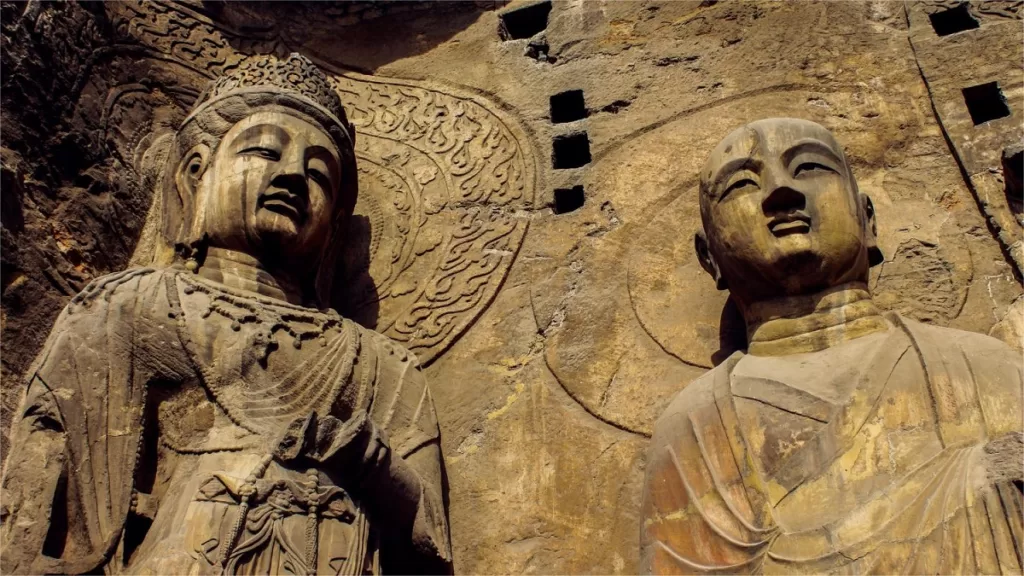武则天与佛教--一个充满活力的交汇点


武则天, also known as Empress Wu, was a remarkable figure in Chinese history who ruled as the only empress regnant in the history of China. Her reign lasted from 690 to 705 during the Tang Dynasty. Wu Zetian’s reign coincided with a period of great cultural and religious diversity in China, and one of the prominent religious influences during her time was Buddhism. In this essay, we will explore the intersection between Wu Zetian and Buddhism, shedding light on the empress’s relationship with Buddhism and its impact on her reign.
Buddhism had been introduced to China several centuries before Wu Zetian’s reign, during the Han Dynasty. However, it was during the Tang Dynasty that Buddhism flourished and became deeply ingrained in Chinese society. The influence of Buddhism extended to all levels of society, including the imperial court. Empress Wu herself was a devoted Buddhist and actively promoted the religion during her rule.
Wu Zetian’s interest in Buddhism was multifaceted. On one hand, her personal devotion to Buddhism shaped her own spirituality and beliefs. She was known to be an avid practitioner, regularly attending Buddhist rituals and engaging in meditation. She even composed Buddhist sutras and sponsored the translation of Buddhist scriptures. Wu Zetian’s devotion to Buddhism can be seen as a reflection of her search for spiritual enlightenment and her desire to understand the deeper meaning of life.
On the other hand, Wu Zetian’s association with Buddhism was not solely driven by personal beliefs. She recognized the political and social potential of Buddhism and strategically utilized it to consolidate her power. Wu Zetian’s support for Buddhism was instrumental in gaining the favor of the Buddhist clergy and winning the support of the Buddhist community. By aligning herself with Buddhism, she tapped into a powerful social and religious force that helped legitimize her rule and maintain stability in the empire.
Wu Zetian’s patronage of Buddhism extended to the construction of Buddhist temples and monasteries. She initiated the construction of numerous Buddhist sites, such as the Great Shangxiang Temple and the Giant Wild Goose Pagoda, both of which became important centers of Buddhist learning and worship. These grand projects not only showcased her devotion to Buddhism but also served as symbols of her power and authority.
Furthermore, Wu Zetian implemented policies that promoted the spread and growth of Buddhism. She encouraged the ordination of women as nuns, providing them with opportunities for education and spiritual advancement. This was a significant departure from the traditional Confucian norms of the time, which relegated women to subordinate roles. Wu Zetian’s support for female monasticism challenged societal norms and empowered women within the Buddhist community.
Despite Wu Zetian’s active promotion of Buddhism, her reign was not without controversy. Some critics argued that her support for Buddhism was excessive and that she undermined the Confucian values that had long been the foundation of Chinese society. These critics accused her of using Buddhism as a means to consolidate her power and maintain control over the empire. Nevertheless, it is important to note that Wu Zetian’s reign marked a period of religious tolerance and diversity, where multiple religious beliefs, including Confucianism, Daoism, and Buddhism, coexisted.
In conclusion, Wu Zetian’s relationship with Buddhism was complex and multifaceted. Her personal devotion to Buddhism and her strategic use of the religion as a political tool both played significant roles in her reign. Through her patronage of Buddhism, construction of Buddhist sites, and support for women in the monastic community, Wu Zetian left a lasting impact on the development of Buddhism in China. Her reign stands as a testament to the dynamic intersection between religion and politics, where Buddhism played a pivotal role in shaping the course of Chinese history.
有关武则天的其他信息